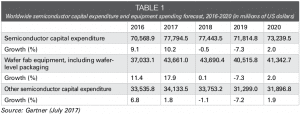 Worldwide semiconductor capital expenditure is projected to increase by 10.2 per cent in 2017, to US$ 77.7 billion, according to Gartner Inc. This is due to aggressive investments in memory and leading-edge logic, which are driving spending on wafer-level manufacturing equipment.
Worldwide semiconductor capital expenditure is projected to increase by 10.2 per cent in 2017, to US$ 77.7 billion, according to Gartner Inc. This is due to aggressive investments in memory and leading-edge logic, which are driving spending on wafer-level manufacturing equipment.
By Baishakhi Dutta
According to Takashi Ogawa, research vice president at Gartner, “Spending momentum has been more concentrated in 2017 mainly due to strong manufacturing demand in the domains of memory and leading-edge logic. The NAND Flash shortage was more pronounced in the first quarter of 2017, leading to over 20 per cent growth of etch and chemical vapour deposition (CVD) segments in 2017 with a strong capacity ramp-up for 3D NAND.”
According to Gartner’s latest view, the next down cycle in capital expenditure will emerge in 2018 to 2019, which is earlier than the 2019 to 2020 down cycle predicted in the previous quarter’s forecast. “Spending on wafer fab equipment will follow a similar cycle with a peak in 2018. While the most likely scenario is that positive growth will continue in 2018, there is a concern that the growth will turn negative if the end user demand in key electronics applications is weaker than expected,” says Ogawa.
 This research report has been produced by Gartner’s Semiconductor Manufacturing programme. This research programme, which is part of the overall semiconductor research group, provides a comprehensive view of the entire semiconductor industry, from manufacturing to device and application market trends.
This research report has been produced by Gartner’s Semiconductor Manufacturing programme. This research programme, which is part of the overall semiconductor research group, provides a comprehensive view of the entire semiconductor industry, from manufacturing to device and application market trends.
To analyse the future of the semiconductor industry in India, the Electronics Bazaar team reached out to a few experts in the industry to assess their views.
The experts’ views
Srinivas Prasad, VP and head, semiconductor business unit, Sasken Technologies Limited
“I believe that the semiconductor industry will continue to grow impressively throughout 2017. The increased requirements of data centres are creating surplus growth in the memory market. Also, after a long time, sales of semiconductors have increased across regions without an exception (Asia Pacific, North America, Japan and Europe). The significant increase in cloud data centres is creating surplus demand in the memory market, and all the companies in this companies in this space (like Western Digital and Micron) are growing significantly,” Prasad states.
Rahul Bagchi, AVP, product engineering services, Sasken Technologies Limited
“As far as current drivers are concerned, the most significant are cloud computing, Big Data and artificial intelligence that are increasing the demand for servers and data centres exponentially. Intel and NVIDIA are the strongest positioned here. High performance computing is where a lot of the innovation is going on, and NVIDIA is leading the market because of its leg-up in machine learning. But, of course, it won’t be alone there. Intel is in the game with the technology it acquired through Nervana. Both companies are working on hybrid solutions, because GPUs do a better job of processing the huge amounts of data to train a neural network while CPUs do a better job of applying that data to a given situation. Xilinx is another important player working with FPGAs on top of ARM-based chips. Qualcomm could as well surge ahead with its ARM-based server chips at some point in the future. Hybrid seems to be the future here – GPU+CPU, FPGA+CPU and DSP+CPU. Each has its own advantages, ranging from performance and power consumption to latency,” says Bagchi.
Talking about current market trends, Bagchi says, “One of the fastest growing emerging markets for semiconductor devices is automotive, as the consumption of electronic components for safety, infotainment, navigation and fuel efficiency continues to increase. Primary areas of growth are hybrid electric vehicles, infotainment, telematics and connectivity, and advanced driver assistance systems (ADAS), where the estimated 5-year CAGR for chip demand is 20 per cent. Infineon, STMicroelectronics and Renesas are important players. Qualcomm, after its acquisition of NXP Semiconductors, which had earlier acquired Freescale Semiconductor, has become a major player in automotive semiconductors. The automotive segment also has an emerging adjacent market in the form of autonomous/self-driving cars that will consume a huge number of semiconductors, particularly the sensors, processors and other technology that enables these vehicles.”
Another important segment for semiconductor companies that is relatively low key is industrial. “Since semiconductors facilitate increased automation on the factory floor, they are increasingly used to drive efficiency and lower costs. This is expected to drive a 10 per cent CAGR for chips in this category,” Bagchi says.
With respect to the emerging drivers, he says, “Most of the emerging technologies fall in the Internet of Things (IoT) category. This is expected to increase the demand for semiconductors by about 20 per cent annually over the next few years. Major drivers include smart cities, connected vehicles, wearables, connected homes and industrial Internet chips. However, this is still a nascent market with several challenges to its continued growth. These would be: security/privacy because of the huge amount of data generated and collected, the still-limited availability of consistent standards enabling interoperability, relatively low ROI for chipmakers necessitating the integration of additional technology for the final product by the chipmaker, and the possibility of a growing number of niche products.”
Daisuke Nakamura, managing director, ROHM Semiconductor India Pvt Ltd
“At present the semiconductor market is huge and is crowded. In this process, a lot of memory is being used. So the demand for memory is increasing rapidly, which in turn is causing supply constraints in terms of the wafers. I personally believe that investments in the semiconductor market will be gradually increasing. This particular industry is growing and will continue to grow because of the huge demand that is being created. Five years down the line, I see India becoming a rich country alongside which the demand will keep on rising.”
(Source: Original report published by Gartner)




























